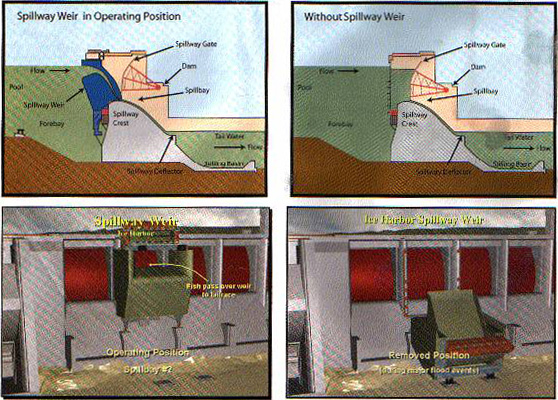 This note responds to John McKern's letter printed in the latest CBB.
This note responds to John McKern's letter printed in the latest CBB.
John's letter includes at least the following distortions:
- The Corps' RSW at Lower Granite Dam passed a high percentage of steelhead and chinook smolts during low-flow years such as 1993. BUT, that was predicated on a strong upstream flow field associated with 7000 cfs surface-oriented attraction flow. Reducing RSW flow would reduce smolt passage rates.
- As smolts are surface-oriented, especially during daylight hours, they pass much more quickly over the RSW than through turbine 60 ft deep intakes. Research affirms forebay delay is proportional to smolt mortality. Reducing RSW flow would result in greater smolt passage delay and higher forebay smolt mortality rates.
- 98% survival via transportation is to the downriver release site only, and overlooks delayed mortality from truck and barge travel modes. Proof is that SARs in many years are higher for fish that passed in-river and were not transported. That's why transportation rates are around 10%.
- RSW spill survival is optimized by spilling a modest amount of flow in adjacent spill bays to assure flow from the RSW moves efficiently down the primary tail water channel and does not swirl in the tail race resulting in high aquatic predation rates. Extensive physical hydraulic modeling enabled RSW "training spill" schedules to accommodate the full suite of dam operating conditions for that purpose.
I was the NOAA Fisheries fish passage engineer before retiring in 2004, and co-authored a 2006 paper with Walla Walla District personnel that appeared in Hydro Review magazine on initial 2003 Lower Granite RSW bioengineering research results. Unfortunately, there are still those who cherry pick selective data to distort events from earlier decades. As always, the devil is in the details
Related Pages:
Giant Weir Aims to Help Small Fish by Anna King, Tri-City Herald, 2/23/5
Steve Rainey
When It Comes To Fish Passage Survival Data, The Devil In The Details
Columbia Basin Bulletin, April 26, 2022
See what you can learn
learn more on topics covered in the film
see the video
read the script
learn the songs
discussion forum



 This note responds to John McKern's letter printed in the latest CBB.
This note responds to John McKern's letter printed in the latest CBB.
